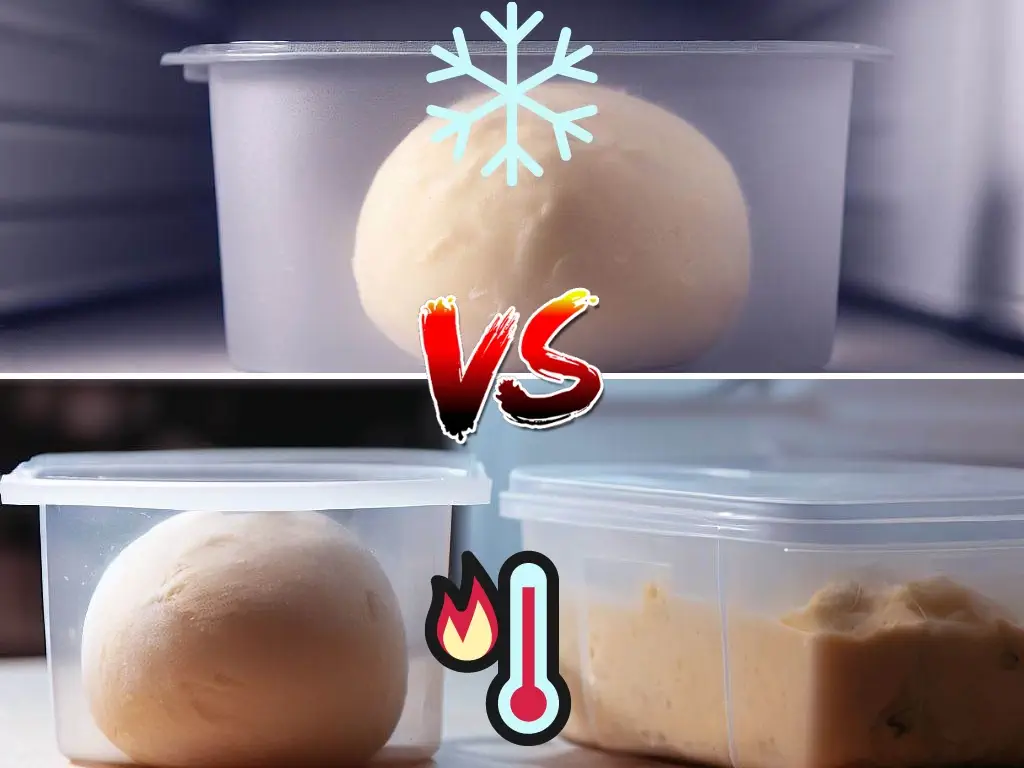Room Temperature vs. Fridge: How Fermentation Temperature Affects Pizza’s Flavor and Texture
When it comes to dough fermentation, there are two primary fermentation methods: cold fermentation and room temperature fermentation. In this article, we’ll explore how these methods differ, examine their advantages and drawbacks, and discuss their impact on texture, flavor, and more – helping you decide which method best fits your needs
Introduction: Cold vs. Room Temperature Fermentation
Before discussing the differences between cold and room temperature fermentation, it’s important to first understand how temperature influences the dough, and what each fermentation method actually entails.
In the sections ahead, we’ll define “cold fermentation” and “room temperature fermentation” from both a technical and practical perspective, and also look at how temperature affects the dough’s internal processes.
How Temperature Affects Dough Fermentation
You can read more about the role of temperature in fermentation in this article: What Affects How Fast Pizza Dough Ferments – and How You Can Control It.
In short, the dough’s fermentation temperature greatly impacts both the fermentation and ripening processes, and, as a result, the overall rate of fermentation.
Generally speaking, the warmer the dough, the more active the yeast, enzymes, and bacteria will be. This increased activity leads to faster fermentation (rising and ripening) – including more rapid flavor development.
Put simply: higher fermentation temperatures mean faster fermentation and flavor development.
At room temperature, dough ferments and develops flavor 4–8 times faster than dough that is cold fermented (depending on the exact temperature.)
For example, let’s compare fermentation at 20°C (68°F) to 4°C (39°F) – the average home refrigerator temperature. In this case, every hour of fermentation at 20°C, is roughly equivalent to six hours at 4°C.
That means 6 hours in the fridge produces a similar level of ripening and flavor development as just 1 hour at 20°C. Likewise, 48 hours of cold fermentation would roughly match about 8 hours of room temperature fermentation at 20°C.
What Is Room Temperature Fermentation?
In baking, room temperature fermentation refers to any fermentation carried out outside the fridge – typically within a temperature range of 15–30°C (59–86°F).
Room temperature fermentation is the oldest fermentation method, which makes perfect sense – refrigerators, and therefore controlled low-temperature environments, simply didn’t exist for most of human history.
Even today, many artisanal bakeries still use [long] room temperature fermentation. Furthermore, the vast majority of pizzerias in Naples – often considered the pizza capital of the world – ferment their dough at room temperature, for anywhere from 8 to 24 hours.
What Is Cold Fermentation?
In baking, cold fermentation means fermenting the dough inside a refrigerator, typically within a temperature range of 1–7°C (34–45°F).
The principle behind cold fermentation is simple: chilling the dough slows down the fermentation process. This is why cold fermentation is sometimes called “retardation” – a deliberate slowing or delaying of fermentation.
Cold fermentation works on the same principle as food storage. When food is kept cold, the activity of bacteria and other microorganisms slows dramatically, preventing spoilage and extending shelf life. Likewise, when dough is refrigerated, yeast and bacterial activity slow down, “stretching” the fermentation over a much longer period.
Cold fermentation has become the most popular fermentation method among home bakers, and is widely used by professionals as well. Its popularity comes down to convenience: slower fermentation gives bakers more flexibility, a larger margin of error, wider usability window and less risk of over-fermentation.
“Usability window” refers to the period when dough is at its ideal fermentation stage – neither under- nor over-fermented – and will deliver the best baking results. The larger the usability window, the longer the dough can be used after reaching peak fermentation, while still maintaining optimal handling properties and baking performance.
Room Temperature vs. Cold Fermentation: Characteristics, Advantages and Drawbacks
Now that we’ve covered the principles behind each fermentation method, we can look at how they influence the dough’s characteristics, and discuss the pros and cons of each method.
Effect of Fermentation Temperature on Flavor Profile
When it comes to flavor development, room temperature fermentation works much faster than cold fermentation.
In practical terms, if we imagine a specific “flavor point” we want to reach, dough fermented at room temperature will get there 4–8 times faster than dough fermented in the refrigerator.
Speed aside, the flavor profiles produced by each method differ due to the distinct byproducts generated during fermentation.
In yeast-leavened dough (and sourdough), two main acids play a direct and indirect role in shaping flavor – lactic and acetic acids:
- Lactic acid: Higher concentration at warmer fermentation temperatures (room temperature). Produces a mild, complex flavor reminiscent of yogurt.
- Acetic acid: Higher concentration at colder fermentation temperatures (cold fermentation). Produces a sharper, more pronounced sourness reminiscent of vinegar or lemon.
In summary:
- Room temperature fermentation → More lactic acid → Delicate, yogurt-like flavor.
- Cold fermentation → More acetic acid → Sharper, vinegar/lemon-like flavor.
Neither profile is inherently “better.” Preferences are entirely subjective. However, in my experience, most people lean toward the lactic acid flavor from room temperature fermentation.
Effect of Fermentation Temperature on Texture
The ratio of lactic to acetic acid, determined largely by fermentation temperature, also affects the dough’s texture.
When all other things being equal:
- Lower temperature (more acetic acid) → Dough tends to be more elastic.
- Room temperature (more lactic acid) → Dough tends to be more extensible.
This happens because acidity strengthens the bonds between gluten-forming proteins, reinforcing the gluten network. Acetic acid “tightens” these bonds more than lactic acid, leading to greater elasticity. Lactic acid, by contrast, yields a softer, more extensible gluten structure.
For further reading on elasticity and extensibility in dough, see: Dough Elasticity and Extensibility: Understanding the Two Most Important Properties in Pizza Dough.
In practice, Room temperature fermentation (more lactic acid) may produce:
- More extensible dough
- A more open crumb structure (larger air pockets)
- A more tender crumb
While cold fermentation (more acetic acid) may produce:
- More elastic dough
- A denser, more closed crumb structure
- A chewier, less tender crumb
Note that these are potential effects, when all other things being identical except for the fermentation temperature. Many other factors can influence elasticity and extensibility, covered in detail in the article linked earlier.
Additional Effect on Crust and Browning
Fermentation temperature can also influence the outer crust. Lactic and acetic acid affect the Maillard reaction, the primary process behind dough browning.
When all things being equal:
- More acetic acid leads to thicker crust and more browning
- More lactic acid leads to thinner crust and less browning
This happens because lactic acid inhibits the Maillard reaction more than acetic acid. In simple terms: a dough with higher lactic acid levels will brown less than a dough with the same levels of acetic acid.
Advantages and Drawbacks of Each Fermentation Method
In the following sections, we’ll look at the main advantages and drawbacks of room temperature and cold fermentation, as well as why one may be more suitable for certain bakers or situations.
Room Temperature Fermentation: Advantages and Drawbacks
Advantages of Room Temperature Fermentation
As mentioned earlier, dough fermented at room temperature develops flavor 4–8 times faster than cold-fermented dough.
This is the main advantage of room temperature fermentation – faster flavor development compared to cold fermentation.
This means you can prepare dough the same day without sacrificing flavor or quality, and, in some most cases, even achieve a superior flavor profile.
For many bakers, a 6–10 hour room temperature fermentation will outperform even a long, 48–72 hour cold fermentation in terms of flavor. If you haven’t tried it yet – it’s highly recommended.
Drawbacks of Room Temperature Fermentation
The biggest drawback of room temperature fermentation is that it is far less forgiving. It requires more precision, greater attention to detail, and generally more experience to produce consistently good results.
In the next section, we’ll discuss why fermenting at room temperature is more challenging than cold fermentation.
Summary of Room Temperature Fermentation Pros & Cons
Room temperature fermentation offers greater potential for flavor development and can be more rewarding overall – high risk, high reward.
However, it demands greater precision and skill. The usability window (explained in more detail later) is much smaller, and the margin of error is narrower than with cold fermentation, making it less practical for many bakers, whether at home or professionally.
Why Room Temperature Fermentation Is More Challenging than Cold Fermentation
The challenge of room temperature fermentation lies in the increased intensity of fermentation processes at higher temperatures. These processes, driven by yeast, bacteria, and enzymes, happen faster, which makes them harder to control.
Several factors contribute to this:
- Precision in yeast amount and fermentation temperature: Exact measurement of yeast* and stable temperature control are critical. Even small deviations can cause the dough to under- or over-ferment.
- Very small margin of error: Building on the previous point, because everything happens faster, minor variations in yeast quantity or temperature can quickly push the dough past its ideal state. Cold fermentation is far more forgiving in this respect.
- Special equipment**: To control variables effectively, you’ll need:
- An accurate scale (0.01 g precision) for small yeast measurements
- A thermometer to monitor room temperature
- A probe or infrared thermometer to check final dough temperature (can also be used to monitor room temperature)
- Shorter usability window and less flexibility: Room temperature dough is typically at its best for only a few hours, while cold-fermented dough may stay in peak condition for 1–2 days.
* The amount of yeast can be adjusted to your desired fermentation temperature and time using the PizzaBlab’s pizza dough calculator.
** You can find purchase links to these products in PizzaBlab’s recommended products page.
To illustrate this, think of fermentation like driving:
- When driving slowly (cold fermentation), you reach your destination slower, but have time to spot obstacles ahead, and can easily adjust – large margin of error.
- When driving fast (room temperature fermentation), you reach your destination faster, but need sharper focus and quicker reactions – small margin of error.
In summary: the faster the fermentation, the greater the skill and focus required, and the harder it becomes to correct mistakes.
In terms of usability window: The longer the intended fermentation time, the larger the usability window becomes.
To illustrate, let’s compare two identical doughs fermented at the same room temperature:
Dough A with an intended fermentation time of 10 hours.
Dough B with an intended fermentation time of 2 hours.
For Dough B, each extra hour of fermentation equals a 50% increase over its intended fermentation time.
For Dough A, an additional hour is only a 10% increase beyond its intended fermentation time.
Assuming (hypothetically) that both doughs reach over-fermentation at about 50% beyond their intended fermentation time:
Dough B will reach that point after 1 extra hour.
Dough A will reach it after 5 extra hours.
Obviously, this example is hypothetical, and there are more factors that can affect fermentation speed and dough condition. Still, it demonstrates that the usability window grows as the intended fermentation time increases. Dough B has a very narrow usability window (just one hour before over-fermentation), while Dough A has a significantly larger usability window, about five hours before over-fermentation.
Cold Fermentation: Advantages and Drawbacks
Advantages of Cold Fermentation
The main advantages of cold fermentation are:
- The fermentation process is much more forgiving, offering a large margin of error in factors like yeast amount, fermentation temperatures and final dough temperature.
- There is a wide usability window and great flexibility; the dough can often be used a day or two beyond its intended fermentation time (assuming proper fermentation).
- It is a “set and forget” process – simply place the dough in the fridge and let it ferment with minimal concern about temperature fluctuations*.
* Note that even in the fridge, temperature can vary depending on location (areas at the back of the fridge and/or near ventilation are usually colder), and how often the fridge is opened (frequent opening leads to less stable temperatures.
In short: cold fermentation offers ease of use, convenience and practicality – which explains why it is the most popular method among home bakers and professionals alike.
Drawbacks of Cold Fermentation
The primary drawback of cold fermentation is the much slower flavor development compared to room temperature fermentation. Achieving comparable flavor depth in cold-fermented dough requires significantly longer fermentation times (compared to room temperature fermentation).
Another drawback is the need to plan ahead, which limits spontaneous pizza-making. To develop substantial flavor, dough should ferment for at least one to two days in the fridge, making same-day, cold-fermented pizza, impossible.
As a rule of thumb, one hour of room temperature fermentation equals at least four hours of cold fermentation (and the higher the room temperature, the greater the ratio). For example, 48 hours of cold fermentation is roughly equivalent to 8 hours at 20°C.
Additionally, cold fermentation tends to produce a different flavor profile, often more sour (though this is subjective and depends on personal preference).
Summary of Cold Fermentation Pros & Cons
Cold fermentation offers ease of use, simplicity, and practicality – qualities that make it extremely appealing to many bakers, which explains why it is the most popular fermentation method.
The alternative – room temperature fermentation – is more “complex” and challenging – making it less practical for most bakers.
This is why most educational resources focus on cold fermentation – it’s simpler to execute and suitable for all skill levels.
However, it’s important to recognize that cold fermentation significantly extends fermentation and flavor development times. To achieve complex, deep flavors, cold-fermented dough must be prepared at least a day in advance, which limits the ability to make pizza spontaneously.
Summary: Advantages and Drawbacks of Each Fermentation Method
Here is a summary of the main pros and cons for each fermentation method:
Cold Fermentation:
Advantages:
- Highly convenient “set and forget” process.
- Offers great flexibility with a large usability window – dough can be used even a day or two after the intended fermentation time.
- Fits well with modern, unpredictable schedules and last-minute changes.
- Suitable for bakers of all skill levels, from beginners to experts.
Drawbacks:
- Much slower flavor development; requires at least a full day to match the flavor of room temperature fermentation.
- Requires advance planning, limiting the ability to make pizza spontaneously.
Room Temperature Fermentation:
Advantages:
- Significantly faster flavor development compared to cold fermentation.
- Produces flavor and texture profiles preferred by many.
- Allows for same-day pizza making without sacrificing flavor or texture.
Drawbacks:
- Requires great precision and skill to achieve consistent results, especially for longer room-temp fermentations.
- Needs special equipment (a scale accurate to 0.01 grams and a reliable thermometer).
- Has a small usability window of just a few hours, offering limited flexibility.
Why Is Room Temperature Fermentation Less Popular Than Cold Fermentation?
You’ve probably guessed some of the reasons already, but let’s review the main factors behind room temperature fermentation’s lower popularity compared to cold fermentation (although in recent years, room temperature fermentation has been gaining traction):
- Room temperature fermentation is more challenging: As covered earlier, it requires greater precision, skill, and careful control.
- Ignorance and misconceptions: Many people don’t realize that long* fermentation at room temperature is even possible. Others mistakenly believe cold fermentation inherently produces superior flavor (which isn’t true).
- Common practice in pizzerias: Many pizzerias choose cold fermentation mainly for logistical and business reasons – specifically the large usability window it offers – not necessarily for better dough quality. Because this method is so widespread in professional settings, it’s often wrongly assumed that cold-fermented dough is inherently “professional” or higher quality.
* There’s no strict definition of what constitutes a “long” fermentation at room temperature, since it depends heavily on the fermentation temperature. The higher the temperature, the faster the fermentation, and the shorter the time needed to qualify as “long.”
For example: 4 hours at 30°C (86°F), 6 hours at 25°C (77°F), 12 hours at 20°C (68°F) – all can be considered “long” fermentations at room temperature.
Summary Table: Key Characteristics of Each Fermentation Method
Below is a table summarizing the differences between cold and room temperature fermentation:
| Room Temperature Fermentation | Cold Fermentation | |
|---|---|---|
| (Speed of) Flavor Development | Faster flavor development and dough maturation | Much slower flavor development. Takes 4-8 times longer to reach the same level of flavor development compared to room temperature fermentation |
| Flavor Profile | Milder, yogurt-like flavor | Sharper, lemon/vinegar-like flavor |
| Texture | More extensible dough, more tender crumb, more open crumb structure | More elastic dough, tougher and chewier crumb |
| Ease of Execution / Practicality | Significantly more challenging. Requires great precision, especially with long fermentation times. Less suitable for beginner | A much more “forgiving” process. Requires less precision. Suitable for bakers of all levels |
| Equipment Needed | Precision scale (0.01 grams), a thermometer | None |
| Usability Window | Short usability window (several hours at max) | Very long usability window (1-2- days) |
How to Ferment Dough in the Fridge or at Room Temperature (Practical Guides)
For a detailed guide on room temperature fermentation, see: How to Ferment Pizza Dough at Room Temperature: A Practical Guide.
For a detailed guide on cold fermentation, see: How to Cold Ferment Pizza Dough: A Practical Guide [2 Methods].
Cold Fermentation vs. Room Temperature Fermentation: Concluding Remarks
First, it’s important to recognize that there is no “best” fermentation method, as it depends on your individual conditions, needs, desired results, and limitations. Person X might prefer room temperature fermentation, while person Y might prefer cold fermentation – and both can achieve excellent results.
Generally, room temperature fermentation allows for faster flavor development, allows same-day pizza making, and produces flavors and texture preferred by most people. However, it is also more challenging to manage.
In contrast, cold fermentation offers a convenient, practical dough-making process, with great flexibility and a large margin for error – but it also requires patience and advance planning.
In summary:
- For maximum flavor and texture, room temperature fermentation is best – it’s more demanding, but also more rewarding.
- For ease and convenience, cold fermentation is a better option.
And remember: there’s more than one way to make great pizza. I highly encourage you to experiment with both fermentation methods to find what best fits your workflow, schedule, and personal preferences.
Click here for a practical guide to cold fermentation
Click here for a practical guide to room temperature fermentation
Enjoy the content on PizzaBlab? Help me keep the oven running!








Dear Yuval,
You mention for cold fermentation:
“Assuming the fermentation proces is executed correctly, the usability window of cold fermented dough can be extended for even a day or two with minimal impact on the final product.”
How does this work as the yeast is determined to have full developed dough in the refrigerator for the planned time. A day extra will not make it overproof?
Hi Henk,
The reason why cold fermentation provides a much wider usability window is that all the processes in the dough occur at a slower rate compared to room-temperature fermentation. Let me quote from the article:
“To illustrate this, think of driving – the faster you drive, the quicker you reach your destination, but it also requires more concentration and allows less room for error. If, for example, there is a pothole ahead, driving at a speed of 20 km/h or 10 mph gives you ample time to notice it from a distance and react accordingly. However, driving at 100 km/h or 60 mph reduces your reaction time, and without attentiveness and quick response, avoiding the pothole becomes challenging.”
So, with cold fermentation, it takes longer to reach the same “level” of fermentation and maturation, but it also takes longer for the dough to become over-fermented. In the fridge, the yeast drives at 20 km/h, while at room temperature, it drives at 100 km/h. I hope that made it a little clearer 🙂
Thank you Yuval,
A few more questions to really understand the RT vs CT.
Is the speed really different between RT and CT? One could ferment with a stable RT (say 20 degrees C) with less yeast and ferment the same time as for example a 24 hour CT. The speed will be the same in that case. This would result in the same bandwidth/wiggle room not?
I understand that in general a longer ferment, results in lower speed and therefore more wiggle room. But you mention that a longer CT could remain usable in the fridge for a few days. I know it is true, but I don’t understand it. If I use your dough calculator for a 4 degree C 24 hour ferment I need 0.77% IDY. If I calculate for only one extra day the calculator mentions a 0.31% IDY. That suggests that we strongly overferment, even in the fridge.
My last question is with regard to cooling and warming up phase of a typical CT.
As you mentioned, when putting the dough in the fridge it slowly moves from RT to CT. Also when taking the dough from the fridge before baking there is a higher average temperature than CT (maybe they compensate each other). I entered an example in a multi-stage dough calculator and get next results (I can give you the link, but don’t want to share it publicly out of respect for your own dough calculator. This one I used is based on the same Craig’s table):
24 hour CT at 4 degrees C with 20 degrees RT. Required IDY: 0.32%. Next overview shows the fermentation %:
– In fridge: 2 hours from RT to CT (assumption average temp 15 degrees C) -> resulting in 25% of total
– In fridge: 20 hours CT at 4 degrees C -> resulting in 55% of total fermentation
– Ambient: 2 hours from CT to ready to bake temperature (assumption again average 15 degrees C) -> 20%
This shows that the actual CT time is only 55% of the total fermentation.
Hi Henk,
You’ve touched a good point. In practice, it’s really hard, if not impossible, to determine the exact amount of yeast for cold fermentation because it’s nearly impossible to know the actual temperatures at which the dough will ferment. That’s where the Lehmann method comes in handy, as it simplifies the process and makes it more predictable.
Yes, a 24h RT dough will have a much wider usability window compared to a 2h RT dough. The slower the yeast activity, the wider the usability window. For an emergency dough intended for 2 hours of fermentation, an additional two hours means 100% more fermentation time, while for a 24h RT dough, an additional two hours is only 8% more fermentation time. Obviously, the 2h dough will likely over-ferment with an additional 2 hours of fermentation.
Keep in mind that the yeast amount suggested by the calculator is based on a specific fermentation duration. In a pizzeria, for example, you could use a range of 0.2-0.7% yeast (as per Tom Lehmann’s original suggestion), which will produce a dough that performs well for both 24 hours and 72 hours (or even longer) of cold fermentation. The dough will not behave the same way on the first and third day, but it will still be usable and produce good results. Since we are home bakers and do not necessarily need such a wide window of usability as in a pizzeria, the yeast amount suggested by the calculator will result in a dough that is at its optimal “peak” after the intended fermentation duration specified.
I hope that answers your questions. Let me know if you need any clarifications 🙂
Thanks for clarifying Yuval.
I might do some testing with my wifi temperature logger to see the average ball temperature during the cooling down and warming up fase. Keep you posted if I get some results 🙂
That’ll be super interesting, do update with your results!
Hi Yuval,
What do you think about an apparently “wild” idea to use the Anova precision cooker (destined for sous-vide cooking) as a temperature stabilizer for RT fermentation? One can put the dough balls in separate closed ziplock bags, immerse them in water, set the precision cooker, say, at 25 deg. C (assuming that the actual RT does not exceed this value) and keep the bags in water for a planned time and with yeast percentage according to the calculator. If by chance the actual baking takes place later than scheduled (not much later, but, say, 1-2 hours), the bags with the balls can be put in fridge or even freezer for this delay, in order to stop further fermentation. What do you think of it?
Hi Arie,
Not a “wild” idea at all! You’re essentially creating a fermentation box with precise temperature control, which is a great approach. Just make sure the bags are properly sealed and that there’s enough room for the dough to expand during fermentation. I’d also recommend lightly oiling the dough balls or the inside of the bags to make removal easier.
As for transferring to the fridge or freezer: if the dough is long-fermented (6+ hours), properly managed, and the yeast amount is correct, you’ll have a relatively wide usage window. A delay of 1-2 hours shouldn’t be a concern. That said, I wouldn’t recommend placing the dough in the freezer unless you intend to fully freeze it, as partial freezing can damage the dough’s structure (check out the article on freezing dough for more details).
If you ever give this a try, let me know how it turns out!
This is the best comparison of RT vs CT fermentation that I’ve read, thank you very much for this! I never knew that the two produce different flavors. I am just a relatively new home pizza maker and so I use cold fermentation (for the reasons your article so clearly describe).
I bulk ferment the dough in the fridge then ball it up two hours before the start of baking and leave at room temperature. I’m wondering if there is any advantage to making the dough balls before /after cold fermentation?
Thanks again for the excellent article!
Hi Greg, happy to hear this!
Regarding your question – time spent in bulk vs. balls affects the dough’s elasticity and extensibility, and in the case of cold fermentation, it also influences the fermentation rate. For a complete breakdown, I recommend reading:
1. Pizza Dough Bulk and Ball Fermentation: A Complete Guide
2. How to Cold Ferment Pizza Dough: Guide to Cold Fermentation (2 Methods) (specifically the Lehmann method)
Hi Yuval, thanks very much for the quick response and the links, much appreciated!
What about a combo of RT+CT? Am I crazy to do this?
I typically do RT of 6-8h, then CT overnight, balling next day in morning, baking in evening (and depending how to balls rise from starting cold, they may spend the full day on the counter before baking, or go in fridge for couple hours before baking if it is too hot outside). Pizzas normally come out fantastic.
Hi Ivan,
You’re not crazy at all 🙂 But it’s worth noting that in your specific scenario (and in most cases of a medium/long room temperature fermentation followed by cold fermentation), most of the flavor development and dough maturation happens during the RT stage. The fridge stage mainly serves to ‘extend’ the dough’s usability window.
So essentially, this “hybrid” approach is great for convenience (e.g. mixing the dough at night and balling it in the morning, without having to make the whole batch in one go). But I’d be willing to bet you’d get very similar results with just the 6–8 hours of RT fermentation alone.
Cheers!
12 hours at 20°C (28°F). Thought you might want to double check the conversion? It is in the “info” box above the “summary table”. Thank you for the hard work, great job.
Whoops, supposed to be 68F. Fixed it, thanks for the heads up!